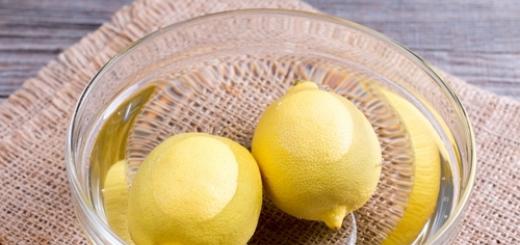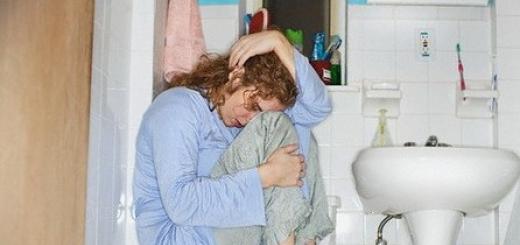Having just appeared on the market, acrylic bathtubs have won universal love and have become widespread. The popularity of acrylic bathtubs is not surprising: the products are different affordable price, strength, low thermal conductivity, lightness and, importantly, attractive appearance. But, like any plumbing, an acrylic bathtub is prone to contamination and requires special care. How to maintain the whiteness and smoothness of the acrylic surface, while not damaging it - read below!
Which of the detergents and cleaning devices to treat the surface of acrylic sanitary ware depends, first of all, on the properties of the material. Acrylic is a liquid metal that, when chemical reagents are added, becomes solid. In order not to disturb the structure of the coating (after all, some products can simply corrode acrylic), you should choose gentle products and soft sponges for washing. Before you start cleaning the surface of the bath, you will need to carefully familiarize yourself with the components of the selected product.

So, mixtures in which you can find:
- Chlorine. Leave the idea to carry out disinfection with chlorine: with a single use of this substance, the acrylic will sharply become cloudy, and with regular use, small pores will begin to appear on the surface of the bath.
- Acetone (and other solvents), alcohol. These substances, with prolonged contact with the surface of the bath, corrode acrylic.
- Ammonia, acids and alkalis as well as solvents will damage surface integrity. acrylic bath.
- Formaldehydes. Although household chemical companies are gradually removing these substances from their formulations (due to the danger to human health), it is still worth knowing about the incompatibility of such a component with acrylic.
In addition, acrylic cleaners should be “soft”, i.e. not contain abrasive particles that can leave small scratches on the smooth surface of the bath. Although you can polish the acrylic surface yourself (you can even eliminate large cracks and chips), but this is an extremely time-consuming task. And why do a job that can be easily avoided by buying a special tool.
Household chemicals: is it possible to wash an acrylic bath with white
It is impossible to clean a bath with an acrylic thicket with an accessible and familiar whiteness: the product corrodes the surface after several times of use, making it porous. And a porous surface without a top protective layer becomes an ideal place for the formation of rust, stone plaque. A bathtub damaged in this way will either have to be repaired for a long time, or completely replaced.

Stains that cannot be removed with detergents must be removed mechanically: wipe the surface with soft sandpaper and cover the damaged area with liquid acrylic.
Some housewives choose weak solutions of bleach and whiteness in order to disinfect the nozzles in hot tubs: for this you have to fill the container with water with solutions, which is also not very useful for coating. Moreover, for such systems, today, separate compositions have been developed that take into account all the properties of materials. Among them are: Mellerud, Cascade Complete, Edel Weiss, Santekh.
How can you wash an acrylic bath
Special compositions for washing acrylic baths prolong cleanliness by protecting the bath with a thin waterproof film. In addition, the acrylic bathtub is cleaned with special products quickly and easily: the compositions do not need to be left on the surface for a long time, but they are washed off with plain water under pressure. The most popular means for washing acrylic are cream-gels Acrylan, Sarma, Star-Acrylat.
In order to get the best result you should:
- Apply the gel to a soft sponge.
- Rub the surface of the bath and leave the composition for 5 minutes.
- Rinse off with water at a temperature not exceeding 30 degrees.
- Wipe the surface of the tub dry with a cloth.

If you can’t find a special product for washing acrylic, then you can use a universal composition. RAVAK Desinfectan cleaner is the most suitable for acrylic surfaces: it is developed using a special technology, gently removes dirt and effectively fights germs.
The acrylic bathtub should be washed with detergent no more than once every 14 days, and after washing off the composition, the surface of the bathtub should be wiped dry with a soft, moisture-absorbing sponge.
You can get rid of rust on acrylic surfaces with the help of San Klin, Mister Chester, Triton. If, in addition to cleanliness, you also pursue the goal of cleaning the surface of bacteria and microorganisms, then you should choose a detergent with antibacterial and antifungal additives. Among these are: Luxus professional, Cillit Bang, Cif.
Is it possible to clean an acrylic bathtub with soda
It will help to clean the bathtub with an acrylic surface and the soda familiar to everyone. The substance is sold in two versions: food and calcined. The second option is a strong alkali and is not suitable for cleaning acrylic surfaces.
In order to wash an acrylic bath with ordinary soda, you must:
- Apply the composition to a soft, damp sponge, rub with your fingertips to soften the particles.
- Rub the surface with the composition and leave it for 60 minutes-1.5 hours.
- Rinse the product completely off the surface with warm water under low pressure.

When washing the bath with any means, you should protect the skin of the hands with rubber gloves, do not touch, during cleaning, the skin of the face and body, household appliances, so as not to get poisoned or irritated by chemicals.
Therefore, often the usual baking soda in equal proportions mixed with calcined and dilute the composition with water in a small amount. The mixture is applied in the same way as baking soda, but after 25 minutes a solution of bleach (half a glass) with vinegar in proportions of 1: 1 is applied over the composition. After half an hour, the surface is rubbed with a soft sponge and the compositions are washed off. This method, although effective, can be dangerous for acrylic (especially low-grade). Therefore, it is advised to resort to it only when absolutely necessary. It is forbidden to use this method as a permanent detergent due to the detrimental effect of solvent and alkali on acrylic.
Cleanliness of plumbing is a guarantee of the health of all family members. Properly selected acrylic bath cleaner will allow you not only to maintain the gloss and whiteness of the surface, but also extend the service life of plumbing, protect its surface from the harmful effects of moisture, pathogens and fungi. Choose the recommended products and enjoy the cleanliness and safety of your bath!
A clean and sparkling bathroom is the pride of any hostess. However, keeping it in perfect order requires a lot of effort. This is especially true for apartments or houses in which large families live.
By purchasing acrylic bath, many housewives are sure that it is necessary to wash it exclusively with special expensive means. However, practice shows that this is not the case at all. In our article we will tell you how to wash an acrylic bath at home. From the listed options, you will surely find an effective and rational option that suits you.
Why acrylic?
Previously, bathtubs were made of cast iron or steel, so they were heavy and massive, which did not suit all consumers. Acrylic bathtubs have appeared on the modern plumbing market relatively recently and have the following advantages:
- smooth and perfectly flat surface;
- light weight.
How not to wash an acrylic bath at home
To begin with, we propose to deal with the techniques and methods that categorically cannot be used to clean an acrylic bathroom. If you want the product to serve you faithfully for many years, remember the means that are strictly prohibited during disinfection:
Bleach
Never attempt to clean the surface of an acrylic bathtub with pure chlorine or chlorine-containing products! Instead of a glossy and uniform shiny surface, you will get muddy bath walls. If you re-chlorine the acrylic surface, you will get a bathtub full of small pores, into which dirt will constantly clog.
Laundry detergents and detergents with abrasives
 Everyone knows that abrasive particles easily scratch any surface, including acrylic. Naturally, scratches and damage can be rubbed and polished, but in the case of a curved bathtub surface, this will be a very problematic task.
Everyone knows that abrasive particles easily scratch any surface, including acrylic. Naturally, scratches and damage can be rubbed and polished, but in the case of a curved bathtub surface, this will be a very problematic task.
Ammonia
With prolonged use of ammonia solutions, acrylic is gradually destroyed, and the glossy surface becomes dull and unaesthetic.
Acetone, solvents, gasoline
These are the products that can quickly ruin the acrylic surface, making it cloudy and unattractive. And with prolonged exposure, solvents, like ammonia, corrode acrylic.
Formaldehydes
In modern everyday life, formaldehyde-based products are no longer used, but just in case, it is important to know about their incompatibility with acrylic coatings.
Acrylic bathroom care tips
 To prevent global pollution, it is enough to rinse the enamel after taking a bath hot water or a soft sponge with regular soap. Tip: If you treat polished acrylic enamel with hot water, the surface will shine even more!
To prevent global pollution, it is enough to rinse the enamel after taking a bath hot water or a soft sponge with regular soap. Tip: If you treat polished acrylic enamel with hot water, the surface will shine even more!
The main rule: no brushes and coarse metal washcloths! All detergents must be applied only with soft cloths or non-abrasive sponges. Useful advice: Before trying out a new cleaner, try it on an inconspicuous area of the tub. Wait 10-15 minutes: if there are no negative changes, feel free to start cleaning.
You should be attentive to the disinfection of acrylic bathtubs, because without special care, pathogenic harmful microorganisms accumulate in nozzles and pipes. The main thing is not to use chlorinated solutions! Specialized products also often contain chlorine, but its effect is smoothly leveled by other components.
Important: to make the enamel of the bath shine, the acrylic is rubbed in a circular motion with a soft cloth dipped in a wax-based polish.
Possible pollution of the acrylic bath and methods of elimination
Sooner or later you will have to face different types contaminants, so you need to be prepared to quickly eliminate them. We list the most common:

Solutions for cleaning acrylic bathtubs and removing limescale
Acrylic is one of the varieties of plastic (polymer) and is characterized by high performance. Unlike a steel bath, the material does not rust or flake, and is also not afraid of water: even dirty, hard or very hot.
Polymers do not support the active use of household chemicals, and the use of non-household chemicals is completely excluded. How to deal with pollution? It is necessary to use an active medium that is not capable of reacting with the surface. These include citric acid and vinegar.
However, it is dangerous to use them in a pure, undiluted form, unlike aqueous solutions.
Acrylic bath cleaning solution

In stores today there are a lot of specialized tools with which you can remove lime or rust deposits. But if you do not want to overpay, we recommend that you listen to the advice on how to wash an acrylic bath at home + from limescale.

Acid solutions perfectly remove water stone and limescale at home, which many products cannot handle.
We rid the acrylic bath of defects
Acrylic enamel is subject not only to pollution, but also to scratches of various depths. At the same time, acrylic is in some way a unique material, because how easily it scratches, how easily these scratches are then eliminated.
 To remove minor damage to the enamel (up to 0.5 mm deep), take a piece of ordinary felt and polish the surface. If the scratches are pronounced and deep, they can only be eliminated with the help of liquid acrylic. In this case, there is no need to call the master: it is enough to purchase an acrylic bath repair kit, consisting of a plastic spatula and a tube of liquid acrylic, which is applied to the damage. After drying, the place of application is polished with felt.
To remove minor damage to the enamel (up to 0.5 mm deep), take a piece of ordinary felt and polish the surface. If the scratches are pronounced and deep, they can only be eliminated with the help of liquid acrylic. In this case, there is no need to call the master: it is enough to purchase an acrylic bath repair kit, consisting of a plastic spatula and a tube of liquid acrylic, which is applied to the damage. After drying, the place of application is polished with felt.
Even a through hole can be sealed with liquid acrylic. To do this, adhesive tape is glued on the outside of the bathtub and the space is filled with acrylic in several stages.
Sometimes damage and pollution are so strong that you can save an acrylic bath only with the help of special inserts that are sold in plumbing stores.
Remember: acrylic is afraid of exposure to high temperatures! Therefore, even the ashes from a cigarette will leave a noticeable stain.
Treat your acrylic bathtub carefully and carefully, then acrylic sanitary ware will serve you for many years!
Perfectly clean plumbing is the desire of every housewife. However, choosing at home, you should choose the right tactics. Otherwise, you can say goodbye not only to an unpleasant plaque, but also to the plumbing itself. Therefore, we will consider at home and what means are completely unacceptable for this coverage.
Care rules
For regular preventive washing, you should use a soft sponge and a specially designed product (about how, at home, will be discussed below).
The washing process is extremely simple. Initially, the surface must be moistened with water. After that, a cleaning agent is applied to a soft rag or sponge and the bath is wiped. The surface must be rinsed with water and wiped dry. To make it shine, you can use a wax polish.
The more often you resort to the usual washing of the surface, the less often you will begin to think about how to clean the acrylic bathtub from plaque at home. It is recommended to repeat this procedure once a week.
Prohibited funds
Acrylic bathtub has many advantages. However, she also has one significant drawback - this is low mechanical strength. Therefore, it is important to know how to wash an acrylic bath at home, in order not only to provide it with a perfect look, but also to protect the surface from damage.

- Brushes with a metallic or other hard coating.
- which contain substances: chlorine, ammonia, acetone, formaldehyde, abrasive components.
- Washing powders.
Products intended for cleaning acrylic bathtubs
For washing the surface it is allowed to use which do not contain aggressive components. This will allow you to quickly and easily clean the plumbing.
There are also specially designed products for these surfaces. So, how to clean an acrylic bath at home?

Consider the most popular means:
- "Acrilan". The substance acts very quickly on the surface and is quite effective. It removes mold, rust, soap residue, plaque. Does not leave behind microdamages, scratches. The bath after using this product is covered with a light protective film.
- "Ravak". These are products that are used to remove grease, stains, rust, scale. They perfectly disinfect the surface.
- Acrylic Polish. Effective remedy designed for acrylic surface. Differs in low cost.
- Team Pro. A modern product that does not contain abrasive ingredients. It allows you to achieve crystal clearness and at the same time does not leave scratches.
- "Mr Chister" A fairly cheap solution that can effectively eliminate rust and plaque. In addition, this tool has an antifungal and antibacterial effect.
Water stone removal
The main problem that arises for people who have installed an acrylic bath is plaque on the surface. However, removing it is quite easy. So, how to wash an acrylic bathtub from plaque at home?

To remove the water stone, the following steps should be taken:
- Take warm water in the bath. Its temperature should not exceed 30 C.
- Add vinegar to the water - 0.5 liters. Instead of this component, you can use citric acid. You will need 1 pack per bath.
- Stir the water with your hand. Leave the bath like this overnight.
- When you wake up in the morning, release the water. Be sure to rinse the surface. Then dry with a dry towel.
Such measures are quite enough to get rid of the raid. But what if there is too much water stone and it was not possible to completely eliminate it? How to wash an acrylic bath at home? The cleaners described above will perfectly get rid of plaque. For example, Akrilan fluids or RAVAK Turbocleane.
Getting rid of yellowness
For acrylic surfaces, such defects are completely uncharacteristic. Often, yellowness occurs in bathtubs made of inexpensive plastic with a protective layer.

Initially, it should be said that such spots appear from poor-quality water, a sharp change in the temperature of the liquid. It is to such situations that plastic reacts with the formation of spots. In addition, it is very important that the acrylic is always dry. It is absolutely unacceptable for water to stagnate in the bathroom. Be sure to check the faucets. They should not drip water onto the surface.
It should be reminded once again how to wash an acrylic bath. Cleaning products specially designed for such coatings will perfectly relieve yellowness at home. You can use the substance "Acrilan". An excellent liquid is Tim-Profi. Such a tool effectively cleans even very neglected surfaces. In addition, it perfectly disinfects the bath.
Citric acid will perfectly clear the yellowness. It is recommended to dissolve 1 sachet in 1 glass of water. Apply the resulting liquid to the acrylic surface. Then rinse it thoroughly. Your bath will be white again.
Tool check
If the necessary liquid was not at hand, you can use another one. However, how to choose the right one that cleans perfectly and does not harm the surface?
First, be sure to study the composition of the substance. The agent should not contain aggressive components.
Further, in order to determine how to wash an acrylic bath at home, it is recommended to resort to a little trick. Apply your chosen liquid to a small area. Choose an inconspicuous area. For example, on the side. And it is best to apply the product on the bottom of the bath. Leave for 20-30 minutes. Then rinse the area. Carefully examine how the bath has reacted to this cleaner.

If no defects were found, then the liquid is completely suitable and you can proceed to the washing procedure.
Bath disinfection
Acrylic surfaces are generally not conducive to the growth of mold and microorganisms. However, even they need regular disinfection measures. Therefore, when planning how to wash an acrylic bath at home, be sure to think about such a cleansing. This is especially true for families with children. Do I need to expose the crumbs to additional risk?
Bath disinfection is a fairly simple event that is recommended to be carried out once a year.
For the procedure it is necessary:
- Take warm water in the bath.
- Add some disinfectant to the liquid. You can use the above liquid "Tim-Profi". Stir the water.
- The bath should remain in this state for 10-15 minutes. Then release the liquid.
- Be sure to rinse the surface. All residual solution must be removed. Don't forget to wipe the tub dry.
Chlorine disinfection
There is another method to clean the surface. However, you should be extremely careful with it. Because high consistency may damage the surface.

To disinfect with chlorine, use the instructions:
- Get water in the bath.
- Add chlorine to it. The solution should be 7%. Watch the consistency carefully.
- Wait a few minutes. Then open the drain.
- Rinse the surface thoroughly and wipe dry.
It is strictly forbidden to wipe an acrylic bathtub with a pure solution of chlorine. It will not only damage the surface, but also leave behind yellow disgusting stains.
Caring for acrylic baths is not particularly difficult. The main thing is to carry out all procedures regularly and use only those means that will not damage the surface.
You can achieve a sparkling white bath if you know the tricks and use the right products to remove different types of dirt. So, cast iron cannot be washed with bleach or rubbed with a hard sponge, and the usual “old-fashioned” methods with ammonia, salt, vinegar and lemon will help to easily get rid of rust.
It should be borne in mind that an unpleasant color is only half the trouble, in addition to an ugly appearance, such pollution can be dangerous, as pathogenic bacteria multiply in the bath, leading to a number of health problems.
Causes and types of pollution
Causes of dirt and plaque:
- Soap residue - is formed when using shower gels, shampoos, conditioners, etc. Simple rinsing is not enough here, as it is quite resistant and can only be washed off with cleaning products and a brush.
- Limescale - occurs with increased water hardness.
- Rust - comes from the faucet and settles on the walls of the bath, causing yellowness.
- Colored spots - their appearance is most often associated with the inaccurate use of coloring substances, for example, hair dyes, brilliant green, potassium permanganate, etc.
- When repairing an apartment, you should take care of the safety of the bath by covering it with a film, because construction dust settles on it and then it is difficult to wash off.
Ways to clean different types of bathtubs
Depending on what kind of bath you have - acrylic, cast iron - the methods of washing it also differ. So, it is better not to clean the first one with ordinary powder, but to use dish detergent or liquid soap. To wash a cast-iron bath, you will need a fairly soft sponge, as a hard one will leave scratches on the surface. The headache of any housewife is a yellow coating on the walls, which appears as a result of daily contact with water, but it can also be easily eliminated. About everything in order.
Acrylic
The surface of an acrylic bathtub will not withstand aggressive chemicals and, if cleaned regularly, will quickly become unusable. Therefore, it is worth refusing to use products that contain alcohol, ammonia and acids.
Washing such a bathtub with laundry detergent should be avoided, otherwise it will fade and turn yellow.
Dishwashing liquid, liquid soap applied to a sponge - this is what you can use for cleaning. If every 10 days you treat the bath with a special polish containing wax, it will delight you with a beautiful view for a long time.
Compared to an acrylic bath, it is more wear-resistant, but when cleaning it, you should not use chlorine-containing and acid-containing products.
The sponge should also be soft enough, a hard brush will scratch the surface. After aggressive cleaning, it can become even more yellow.
It is best to get rid of traces of rust as soon as they appear. To do this, apply a little hydrochloric acid to the problem area and wash it off after 10-15 minutes. In this case, it is better to wear gloves on your hands.
Old cast iron bath
The main problem of such baths is the formation of rust, limescale and coating with a layer of fat. But even in this case, there are many tools that will help restore purity:
- Whiteness - with its help you can return White color and remove bacteria, fungus, mold, grease and rust. It is used only in a diluted form: 1 part of whiteness and 2 parts of water. The resulting liquid is applied with a sponge to the surface of the bath and left for 20 minutes. Do not neglect gloves when using whiteness, as it irritates the skin. Another cleaning method: draw water into the bath and pour in about 100 ml of liquid, stir and leave overnight, drain in the morning.
- Mister Muscle penetrates deep into stains and destroys them, helping to get rid of grease, dirt, lime and bacteria. Compared to whiteness, this product is more gentle on the surface, but it also costs an order of magnitude more expensive. It is also recommended to wear gloves when using it.
- Gel Cif - effective for cleaning sinks, bathtubs. Easily copes with limescale and rust, restores shine to surfaces.
- Comet is available in powder and gel form. The latter cleans surfaces more gently than powder, which causes additional microcracks. The tool helps to eliminate not only all types of pollution, but also microbes.
- Gel Sanoks - the most effective among all of the above means. It is used when other methods fail. In addition to removing dirt, plaque and rust, it also eliminates unpleasant odors. You should not use it often, only in emergency cases, as it “eats” the surface of the bath.
ceramic
Cleaning ceramic baths has some features:
- should be regular, at least 2 times a month;
- you need to abandon hard brushes, powders and products containing abrasive particles, as they will lead to microscopic cracks in which dirt easily clogs, as well as a decrease in surface gloss;
- the glaze that is used to cover the ceramic bath is not afraid of acids, so you can safely use any liquid cleaners and not be afraid to spoil the surface, but they should not be used more than 1 time in 14 days.
Wooden
Wooden bathtubs are gaining popularity every day, because they are not inferior in quality to the rest, while they are environmentally friendly and have an unusual appearance. Caring for them is more difficult:
- it is imperative to wash the bath after each use in order to prevent the formation of stubborn stains that are difficult to remove;
- use products suitable for varnished surfaces;
- it is worth periodically rubbing with special polishing and protective compounds.
Stone
Modern stone baths are extremely expensive. They come in 2 types: natural and artificial stone. The surface of the second type has no pores, corrosion is not terrible, due to which you can not worry about the appearance of fungus and bacteria.
Care has its own characteristics:
- After each bath, rinse it with running water and wipe it dry with a soft cloth;
- Monthly general cleaning is required. Moisten the bath from the inside and spray with a special detergent without abrasives (eg Delamark Royal Powder). It is worth making sure that it does not dry out, but remains wet during the entire cleaning process. At the end of cleaning, rinse off the remnants of the product, wipe with a cloth, polish with liquid wax.
Kvarilovaya
This is a new kind of polymeric materials. Quaryl is a combination of quartz sand grains with acrylic capsules.
The main feature is resistance to mechanical damage - the material is not subject to scratches compared to acrylic. But the price of such baths is extremely high.
Operating rules:
- refuse extremely hot water;
- you can wash by any means, the material is not afraid of scratches and abrasives;
- due to the extremely smooth structure, it is enough to rinse the bathtub with water after each use;
- do not put near the bath heavy objects, if they fall into it, they can damage the surface.
Marble
A marble bath is an extremely expensive pleasure, and it requires appropriate care:
- chemical cleaning products are prohibited;
- soap solution is used to remove contaminants;
- light tones of marble are bleached with salt and lemon juice mixed to a paste-like consistency. The resulting mixture is applied in an even layer on the marble and left for 15-20 minutes, washed off with soapy water and water. If necessary, repeat the procedure;
- the washed and wiped bath is rubbed with polishing paste to add shine;
- in order to extend the service life, they are regularly sent for restoration, entrusting this matter to professionals.
Removal of the main types of pollution
These include: rust, limescale and mold.
You can get rid of rusty stains not only with household chemicals, but also with the tried and tested "old-fashioned" way:
- ammonia is applied for 2-4 minutes on the stain, and then washed off, you can repeat;
- salt, diluted in a ratio of 1: 1 with vinegar, wipe rusty surfaces;
- squeezed lemon juice is used similarly to ammonia.
To cope with limescale, you can use vinegar and soda:
- soda ash and baking soda, taken in equal proportions, are applied to the entire surface of the bath for 20-25 minutes, lightly rubbed and washed off;
- moisten rags or paper towels with vinegar and cover the entire surface requiring cleaning. The time depends on the degree of contamination, but usually 5-15 minutes is enough. After that, you can wash off the vinegar by rubbing the surface a little.
To destroy mold, a mixture of tablets is effective activated carbon with whiteness. The resulting gruel is applied to the places necessary for processing for 1 hour or more, then simply washed off with running water.
Baking soda sprinkled with vinegar will help get rid of the fungus.
Removal of other types of contaminants
In addition to the above, there are more rare types of pollution. But the fight against them also does not require much effort.
Potassium permanganate and greenery
Any, even very weakly concentrated solution of potassium permanganate leaves on the surface of the bath brown spots. You can destroy them with hydrogen peroxide, lemon juice or citric acid. A bonus after cleaning with these products will be not only whiteness, but also shine.
Brilliant greens are removed with alcohol, but this method is not suitable for acrylic baths - the stain will remain.
After renovation
When carrying out repairs in an apartment or house, it is worthwhile to close the bathtub in advance in order to protect construction debris and materials from getting on its surface.
If the bath is still dirty, then you should not be upset, you can wash it:
- If paints get on the surface, any solvent, for example, White Spirit, will help get rid of them. But do not delay the cleaning process, otherwise the paint will dry out and it will be more difficult to remove it.
- Construction dust can be washed off with soap and water. To give whiteness and shine after the bath is treated with lemon juice or acid.
sealant
Joints and seams are closed with sealant; if it gets on the surface of the bath, it will be quite difficult to wipe off. There are several ways:
- Mechanical removal with a clerical knife. When doing this, remember to take safety measures and wear gloves and goggles.
- Chemical - use agents that dissolve the sealant. For these purposes, a solvent, for example, White Spirit, is suitable.
Cleaning chrome surfaces
The bathroom faucet, shower hose and other chrome-plated products are also affected. various types pollution. To cope with rust and limescale will help:
- baking soda moistened with water;
- table vinegar.
From household chemicals, Cillit Bang Anti-plaque + shine does an excellent job with such pollution. You just need to spray it on all surfaces, and after 5-10 minutes wash it off with a sponge dipped in water.
Other folk remedies
The store has a huge selection of household chemicals that help in cleaning the bathroom. But many housewives trust folk proven methods more.
With their help, you can also remove stubborn dirt and save money from the family budget. There are a lot of such recipes, but among the main ones are the following:
- Soda ash and baking soda are mixed in equal proportions with a small amount of water until a homogeneous mushy mass is formed. The resulting mixture is applied to the areas of contamination, and poured on top of a pre-prepared solution of any liquid bleach with vinegar, taken in the same proportions. Leave for 20-30 minutes, remove with a sponge, rubbing a little especially stubborn stains. It must be remembered that this is an extremely aggressive cleaning method and can only be used on a cast-iron surface. If the bath is made of acrylic, it is better to use a more gentle product - a napkin dipped in table vinegar, wipe the places of contamination.
- 1.5 tablespoons of citric acid are dissolved in a glass of water, surfaces are wiped with this liquid - the method is applicable for enameled and metal types. If the bath is acrylic, it is filled to the brim with water and the same amount of citric acid is added, left overnight. In the morning, drain the water and rinse.
- Take ¼ cup of lemon juice and dissolve borax in it until a slurry is formed. This mass is applied to problem areas and allowed to dry, washed off with running water. If spots remain, repeat. Suitable for all surfaces and types of dirt.
- Hydrogen peroxide is mixed with any powder, in a ratio of 1:1. The resulting paste is applied to rust spots, left for 10-15 minutes and washed off with water.
- For cleaning enamelled surfaces, ammonia and hydrogen peroxide are very well suited, they are mixed in a 1: 1 ratio, then the bath is wiped with a solution applied to the sponge and left for 10 minutes, washed off with water.
- Dissolve soda with washing powder in warm water (1 tablespoon of dry ingredients per 500 ml of water), wipe all surfaces that require cleaning with liquid, after 15 minutes treat with a brush or sponge dipped in hydrogen peroxide, and rinse with water.
- Laundry soap is rubbed on a grater and mixed with soda ash in equal proportions, a little water is added. The resulting solution is applied and left for 1 hour, rinsed with water.











